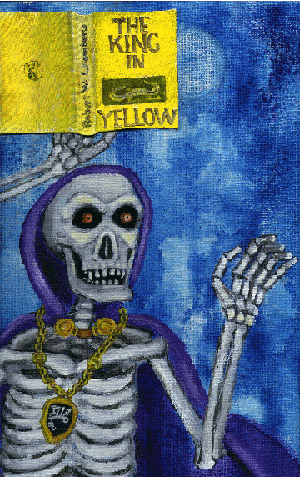 |
Robert W. Chambers (May 26, 1865 to December 16, 1933)
 |
Robert W. Chambers (May 26, 1865 to December 16, 1933)
Continuing his historical-novel phase, Chambers wrote a series about
Revolutionary New York, Sir William Johnson, Walter Butler, and Indian
conspiracies, which still exercise their spell over romantic youth. These
were Cardigan, The Maid at Arms, The Hidden Children, and The Little Red
Foot. Next came the society problem-novels, concerned largely with love
and the obstacles to marriage. The fighting Chance and The Danger Mark
considered the dangers of alcoholic tastes in, respectively, a man and
girl, while The Younger Set and The Firing Line took up the question of
divorce. In spite of the vogue of the Chambers heroine at the time, she
was markedly less convincing than his men. His dramatic instinct found
vent in The Witch of Ellangowan, a vehicle for Ada Rehan, and Iole, a
musical comedy based on a novel which was supposed to lampoon Elbert
Hubbard of Roycrofters. The real model was Aristide Bruant, A Parisian
diseur (for Bruant see Toulouse-Lautrec, by Gerstle Mack). Mr. Keen,
of The Tracer of Lost Persons, is a sentimental detective.
DOWN
In his first twenty years as a popular writer Chambers produced forty-five
volumes, �veering in accordance with the breeze of popular demand.� The
period of 1915-1919 had its quota of war novels. In 1924 he returned to
historical fiction, with the same easy fluency but small critical acclaim,
although magazines continued to pay high prices for his serials. Chambers
was able to gratify his tastes for Chinese and Japanese antiques, old china
and furniture, armor, and the restoration of his early nineteenth-century
home in the Adirondack foothills, called Broadalbin. At a New York office,
whose address was unknown even to his family, he wrote from ten to six.
Fishing and hunting were his relaxations. The novelist was a well set-up
man, with square shoulders and chin and a gray mustache. His manner was
cordial and genial. The National Institute of Arts and Letters numbered
Chambers among its members. On July 12, 1898, he married Elsa Vaughn
Moller. A son, Robert Husted Chambers, attained some success as a writer.
from: 20th. Century Writers